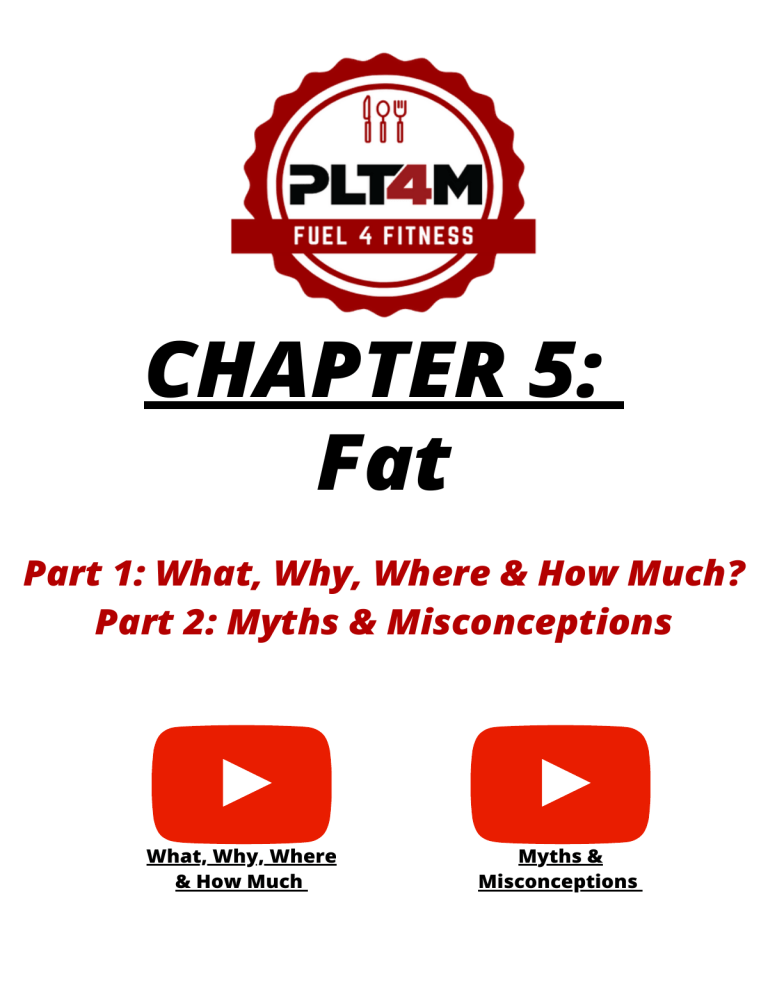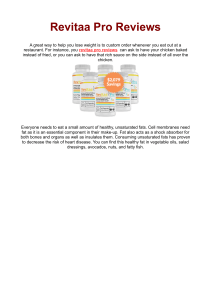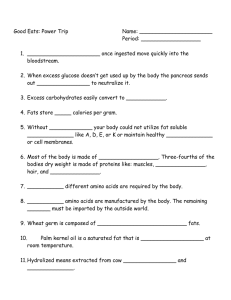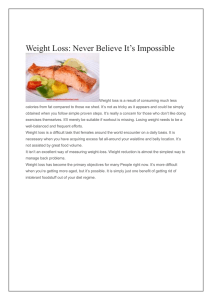
CHAPTER 5: Fat Part 1: What, Why, Where & How Much? Part 2: Myths & Misconceptions What, Why, Where & How Much Myths & Misconceptions Part 1: What, Why, Where & How Much People often misunderstand fat in our food. Just like the other macronutrients (carbohydrates and protein), our body uses dietary fat for energy, but it also supports our health in surprising ways. And just like the other nutrients, depending on where you get your fat, there are some important things to know. What Is Fat? Dietary fat is found in varying amounts in most foods plants and animals. Just like carbohydrates, there are subcategories or types of dietary fats - unsaturated fats, saturated fats, and trans fats. Unsaturated fats can be further divided into more subcategories (see chart). What's important to know is that the chemical structure of each is different and as a result, have varying impacts on the body. Why Do WHY We Need It? IT? DO WE NEED Your body uses fat for a variety of functions - regardless of what type we eat. Dietary fats are a dense source of energy for the body - a small volume contains a large amount of energy. But fats are tough for the body to digest and turn to energy, so they're not an ideal fuel source if you need energy quickly. 50 Beyond energy, fats of all types serve important functions such as: Transport, absorb, and store vitamins A, D, E, and K Contribute to sex hormone production and corticosteroids Form the outer layer of every cell on our body (aka, the phospholipid bilayer) Reduces inflammation in the body which helps recover from sport (Omega 3 fatty acids - a type of unsaturated fat) Form much of the brain Taste amazing and help us feel satisfied Takes long to digest so we feel fuller, longer Where It's Found Fats are found in plant and animal foods. In general, the fat found in any given food is not just one type. For example, food is rarely pure unsaturated fat. Instead, it's a combination of saturated and unsaturated sources. Plant fats and fish fat tend to contain more unsaturated fats. Examples include nuts, seeds, olive oil, olives, avocado, salmon, tuna. Animal fats and tropical plants tend to have more saturated fat. Examples include beef, pork, chicken, cheese, cream, coconut oil, palm oil. 51 Trans fats are unique. They are made of "partially hydrogenated" oils. They are not naturally found in foods. Humans created them years ago to improve the texture and shelf life of processed foods like cookies, cakes, peanut butter, as well as some fried foods. Most trans fats have been removed from our food system, but here and there, you find a few companies still using partially hydrogenated oils. What Do The Types Matter? The human body needs dietary fat, but it prefers a balance of fat types for our overall health. When too much of our dietary fat comes from saturated and/or trans fat, it can impact our heart health in the future, increasing the risk of heart attacks and strokes for some people. In general, most of the fat we eat each day should come from plants and fish or "unsaturated" sources. It's completely ok to have saturated fats, but it's best to keep them a bit smaller part of what we eat. Trans fats have no benefit for the human body and have been shown to be harmful in large amounts. It's best to avoid them when possible, but understand that a little now and again won't harm you. 52 How Much Do I Need? The amount of fat you need each day varies based on how much energy you need overall. As you recall from previous articles, daily energy needs change a lot depending on height, weight, age, physical activity, and so much more. Tracking and/or limiting what you eat based on precise numbers is not recommended, as it's very difficult to predict changing needs. Our body (and health) care more about the average of what we eat over time - not daily perfection. It's better to follow your personal cues (link to article about that). But if you must have a number, in general, the guideline is that 25% of your daily energy comes from fat. For someone eating around 2000 calories per day, that's approximately 55 grams of fat in total from unsaturated and saturated fats. Ideally, saturated fat is 5-6% of total energy or around 13 grams. Again, those are not hard and fast rules. That doesn't mean if you're above or below these numbers, something will happen to you. Instead, it's a reference point. But one way in which the numbers can be helpful is when you look at the food label. Often seemingly "healthy" foods can be very high in saturated fat depending on how it was made. 53 For example, you pick up a bag of chocolate-covered dried bananas - sounds amazing, right? You might assume it would give your body more nutrition than a cookie while still satisfying that sweet tooth. When you looked at the label though, you are shocked to see that a tiny serving had over 20 grams of saturated fat! That's when you notice the bananas were fried with palm oil. So in that instance, you are better off enjoying a cookie than the deceptive health product. Tricky! It's much easier to think about fat in terms of food balance. In general, the goal is to try to choose plant or fish fats more often than animal fats while not relying too much on fried foods and processed foods for your energy each day. Tips to add more unsaturated fats to your routine: Enjoy a handful of nuts/seeds between meals Add nuts/seeds to meals (yogurt, salads) Add avocado to sandwiches and salads Add a side of guacamole to snack/meals Use guacamole instead of mayo on sandwiches Enjoy salmon occasionally Enjoy tuna salad sandwiches 54 Part 2: Myths & Misconceptions Myth - The fat you eat makes you fat No, no, and no. Dietary fat does not become body fat. The fat you eat has to go through a complex process before it’s available as energy. If your body doesn’t need the energy, yes, it will put it in storage. But that’s not unique to fat! Our body is constantly putting nutrients in and out of storage to meet our daily energy needs. Fat is not more easily turned to body fat than any other nutrient. Where fat is tricky is that it is energy dense. A small portion contains more energy than carbohydrate or protein chemistries. So if you’re eating a lot of fat to fill your stomach, it is easier to overeat. But fat is incredibly satisfying. Typically a food with fat will make you feel fuller, longer and makes the food more enjoyable which helps you feel more satisfied. Avoiding fat and/or choosing fat free foods is actually more likely to make you overeat in the long run because you’re hungry more often and don’t have the same level of enjoyment. 56 Myth - Coconut oil is good for you Coconut oil is all the rage right now. Coconut oil is delicious and gives food a tasty texture and flavor when cooking. But it is pure saturated fat. Eating large amounts of saturated fat over a long period of time can lead to heart health problems in the future. That doesn’t mean you can’t have coconut oil. But it’s important to use it in smaller amounts, and less often than other sources of fat. Olive oil is still one of the better options for heart health. 1 T butter 7 grams saturated fat 1 T Coconut Oil 12 grams saturated fat 1 T Olive Oil 2 grams saturated fat 57 Myth - Meat is bad because of saturated fat Saturated fat is found in all animal based foods in varying amounts. There is no food you “can’t” have because of its saturated fat content. Instead, it’s about adjusting portions to try to find balance in your overall day, over time. In general, the higher the fat content of the animal based food, the more saturated fat it will have. 58 Questions 1: How does dietary fat support the body? 2: What are the different types of fat in the diet and where are they typically found? 3: Which type of fat may negatively impact heart health? 59



